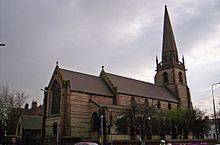OS grid reference SJ 382 924 Country England Churchmanship Anglo-Catholic Opened 1870 | Denomination Anglican Functional status Active | |
 | ||
Similar | ||
The Church of Saint John the Baptist is on the corner of West Derby Road and Green Lane, in Tuebrook, Liverpool, England. It is recorded in the National Heritage List for England as a designated Grade I listed building, and an active Anglican parish church in the diocese of Liverpool, the archdeaconry of Liverpool and the deanery of West Derby.
Contents
History
The church was built between 1867 and 1870, its cost of £25,000 (equivalent to £2,157,276 in 2015), being totally met by the wife of Revd J. C. Reade. The architect was George Frederick Bodley. The interior was redecorated in 1910 by Henry Hare to Bodley's design. This was restored in 1968–71 by Stephen Dykes Bower.
There was controversy before the church was consecrated because Bodley intended to use an early 16th-century altarpiece from Antwerp which had carved tableaux of the Passion as the reredos. However the Bishop of Chester considered it to be too "Popish" and he refused to consecrate the church until it was removed. The altarpiece is now in St Michael's Church, Brighton.
Exterior
The church is built in red and buff stone, which is irregularly banded. The main roof is tiled, while the roofs of the aisles are of slate. Its plan consists of a five-bay nave with a clerestory, north and south aisles under lean-to roofs, a west tower, a north porch, a chancel with a chapel to the north, the organ loft to the south and a detached vestry connected to the chancel by a short passage. The tower has angled buttresses and a west entrance above which is a three-light window. The top stage has two-light louvred bell-openings and a panelled parapet with pinnacles at the corners. The spire is recessed on an octagonal base containing gabled two-light openings and it is attached to the pinnacles by flying buttresses. At the south east corner of the tower is a lean-to stair turret. The porch has a flat roof with a parapet and a niche over the entrance containing a statue.
Interior
Pollard and Pevsner describe the interior as being "glorious" and "richly coloured" due to the "resplendent display of Bodley fittings and the vibrant decoration". The citation in the National Heritage List for England states it is "one of the finest examples of Victorian polychromy". The walls and the roofs are all richly stencilled, and in addition there is a wall painting on the east wall of the nave by C. E. Kempe. The gilt reredos dates from 1871 and has panels painted by Kempe.
The area under the tower has made into the Chapel of the Holy Rood and contains a reredos, an altar and a credence table which were adapted in 1978 from a rood screen of 1890 by Bodley which was taken from Dunstable Priory. The pulpit and the octagonal font were both designed by Bodley, as were the richly painted screens (again with panels by Kempe). The stained glass in the east window and the south window in the chancel is by Morris & Co.; some of the windows elsewhere are by Burne-Jones. In the church is a brass memorial dating from 1926 by Hare which consists of a life-size figure of Rev. Ralph Brockman. The memorial to the First World War is a statue of Mary, also by Hare; that to the Second World War is a statue of John the Baptist by Sir Ninian Comper. The statue commissioned by Canon Sampson might never have been sculpted, for Comper was initially reluctant to undertake this commission, only relenting at the behest of his son, whom Comper then used as the model.
The three-manual organ was made by William Hill and Sons in 1867 and cleaned and improved by the same company in 1895. It is contained in a "magnificent Bodley case, with embossed display pipes". It was restored in 1991 by David Wells. There is a ring of eight bells which were cast in 1869 by John Warner & Sons.
Incumbents
1871–1880 Rev J.C.Reade
1880–1884 Rev J.Lindsay
1884–1892 Fr F.H.Chevenix Trench
1892–1895 Fr P.N. Clark
1895–1896 Fr H.N.Thompson
1896–1925 Fr Ralph T.Brockman
1925–1937 Fr Thomas Brancker
1937–1946 Fr W.H.Tayler
1946–1994 Rev Canon Frank Sampson MA
1994–2010 Rev Canon Paul Nener BM BCh FRCS
2010 – Fr Simon J.P. Fisher MA
Organists
Vicarage
The vicarage, completed in 1890, was also designed by Bodley. It is a Grade II listed building in grey brick with red brick bands and red sandstone dressings. It has three storeys and a tile roof.
